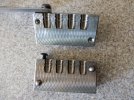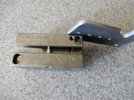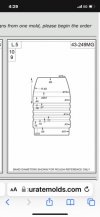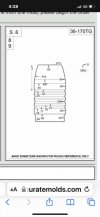You are using an out of date browser. It may not display this or other websites correctly.
You should upgrade or use an alternative browser.
You should upgrade or use an alternative browser.
Advice on 357 and 44 Rifle molds from accurate
- Thread starter Wasalmonslayer
- Start date
Wasalmonslayer
Well-Known Member
My plan is to cast fairly soft tumble lube them and drive em as hard as accuracy allows.
Wasalmonslayer
Well-Known Member
I have that mold already from rcbs.
Never thought about that one.
Will it feed out of the tube on a lever gun and the rotary mag from ruger ok??
Never thought about that one.
Will it feed out of the tube on a lever gun and the rotary mag from ruger ok??
Wasalmonslayer
Well-Known Member
That was my thoughts exactly was hoping someone has some experience with them and could aid some dimensions or advice.
My other thought was add another row of tumble lube grooves to aid in some more “adjustment” each groove can be used to crimp.
My other thought was add another row of tumble lube grooves to aid in some more “adjustment” each groove can be used to crimp.
Petrol & Powder
Well-Known Member
I think Brad hit the nail on the head, the rotary magazine on those Rugers will set the limit on OAL. That being said, I think you'll be fine with any conventional length cartridge.
1. Those rotary mags are durable and reliable.
2. Unless you get crazy with OAL, you'll be fine.
You can make up a dummy cartridge with bullet seated long. Test the dummy cartridge in your magazine and seat it progressively deeper until it fits in the magazine. Add a little seating depth (maybe .020" ?) to deal with slight variations caused by dirt, long cases, bullet nose imperfections, etc., and you have a dummy round that is a "go" gauge.
From that, you can determine the maximum distance allowed between the top of the crimp groove to the tip of the bullet.
As for bullet profile, I think something like a RNFP or a TC that has a flat point but no sharp shoulder like a SWC, will feed fine. Frankly, even a SWC with a pronounced, exposed shoulder on the front driving band will probably be OK in the Rugers as long as the OAL is acceptable. I can't speak for the Winchester.
I don't see a need to go super heavy in either of those calibers. They are both handgun cartridges being used in carbines and likely will be used at shorter ranges. 170-180 grains in the .357, and 250ish in the 44 will give trajectories that are easier to live with inside of typical hunting ranges and still provide plenty of terminal performance. A soft bullet with a flat point that you can consistently put in the right spot is far more useful than a super heavy bullet that drops like a bowling ball at the end of your acceptable shooting distances.
1. Those rotary mags are durable and reliable.
2. Unless you get crazy with OAL, you'll be fine.
You can make up a dummy cartridge with bullet seated long. Test the dummy cartridge in your magazine and seat it progressively deeper until it fits in the magazine. Add a little seating depth (maybe .020" ?) to deal with slight variations caused by dirt, long cases, bullet nose imperfections, etc., and you have a dummy round that is a "go" gauge.
From that, you can determine the maximum distance allowed between the top of the crimp groove to the tip of the bullet.
As for bullet profile, I think something like a RNFP or a TC that has a flat point but no sharp shoulder like a SWC, will feed fine. Frankly, even a SWC with a pronounced, exposed shoulder on the front driving band will probably be OK in the Rugers as long as the OAL is acceptable. I can't speak for the Winchester.
I don't see a need to go super heavy in either of those calibers. They are both handgun cartridges being used in carbines and likely will be used at shorter ranges. 170-180 grains in the .357, and 250ish in the 44 will give trajectories that are easier to live with inside of typical hunting ranges and still provide plenty of terminal performance. A soft bullet with a flat point that you can consistently put in the right spot is far more useful than a super heavy bullet that drops like a bowling ball at the end of your acceptable shooting distances.
Last edited:
Wasalmonslayer
Well-Known Member
I was thinking along those same lines.
Usable range is around a hundred yards give or take and a well placed WFN bullet should handle any animal.
I think I will dummy up a lot heavier bullet to see where I end up on a good usable oal to see if the designs will work.
Thanks guys!!
Usable range is around a hundred yards give or take and a well placed WFN bullet should handle any animal.
I think I will dummy up a lot heavier bullet to see where I end up on a good usable oal to see if the designs will work.
Thanks guys!!
Petrol & Powder
Well-Known Member
Your dummy round doesn't need to be an excessively heavy bullet. (Although it could be if that's what you have). It can just be a standard bullet seated long to start with and then seated progressively deeper until the max acceptable OAL that fits the magazine is found.
Winelover
North Central Arkansas


What I had recently had Tom cut for my 357's revolvers and carbine. Iron mixed cavity 158 RNFP (2 PB+2 GC).
I have a mixed four cavity of NOE's 180 RNFP also but really don't see the need for heavy for caliber bullets, the majority of the time.
For the 44 Specials and Magnums, revolvers and carbines, I like MP 250 RNFP with the three pin option. Solid, cup and hollow point.
I never loaded for the Ruger 44 with the rotary mag but my FIL had one. I recall it having a short throat, I don’t think a 429421 seated normally would feed or chamber. Crimped over the front band it was fine but powder space it lost.
Look at a 240 gr jacketed bullet for guidance. That is the contour and nose length you have to work with.
The 240 WFN would probably work but watch that nose length.
Look at a 240 gr jacketed bullet for guidance. That is the contour and nose length you have to work with.
The 240 WFN would probably work but watch that nose length.
Those two bullets - "RDO clones" will work just as you stated. I've not hunted with them, but have shot them just like you describe, just up to 1800 fps in the 357 - Rossi 92, H&R, Contender Carbine, 77/357 with an MGM Barrel. No leading and excellent accuracy at 50 yards, meaning five shots in under an inch with relative ease. I'm shooting the 359-190. The 190 uses home-made, aluminum gas checks. I did have to trim brass back (.020", I think) to get the 190s to cycle through the Rossi and the Ruger.My plan is to cast fairly soft tumble lube them and drive em as hard as accuracy allows.
The 44 copy, at 265 grains is one I cast for a friend using it in a Smith 44 Mag and a Marlin 1894. He raves about "how well they shoot," but has not provided stats. He is an incredibly meticulous and picky person, so I take his word.
The 44 bullet was the first RDO design I tried and was so pleased that I ended up with a 22 cal, 30 cal, (2) 35 cals, as well as the 44. All have yielded wonderful accuracy. The 22 is the only one I've "hunted" with and it was a very mild target load in the 222, but it was handy, as was the 722, so that is what I used to dispatch a sickly 'coon one day. The little 50-grainer removed 2/3 of his head and distributed it in an oblique "shadow" of pinkish-gray patch for about three feet behind him.
I cast these from straight wheel weights or 50/50 wheel weights/pure lead and bullets recovered from a dirt bank tend to look like a little forearm with a fist on it, when the dirt is wet.
That's all I've got. Never shot a deer with any of them and hove only shot to 50 and 65 yards.
THAT's a beautiful bullet!View attachment 26128
What I had recently had Tom cut for my 357's revolvers and carbine. Iron mixed cavity 158 RNFP (2 PB+2 GC)....
If a I "had to," I could do the vast majority of what I need to do (and well) with that one. I'm talking revolver or carbine too.
Also a beautiful MOULD, and I don't have one of his yet.
Wasalmonslayer
Well-Known Member
I think your advice Brad is very sound.
I’ll go after case length with some Hornady jacketed xtp hollow points and see where I end up.
Really would like to hit this with one mold purchase and be able to feed both guns with one bullet.
That is one of the main reasons for the tumble lube grooves.
I have found them to be very usefully crimp grooves for different lengths.
I use the tl358 158 swc that way for my black hawk 357.
I expose 3 rings and crimp in the 4th.
Accuracy is outstanding with 5grns of bullseye.
Use the same load with two grooves exposed and crimp in the third in my gp100.
Same principle for my 44’s except my dang model 69 5 shot 44 mag. It leads the last 2” of the barrel unless it has a gas check or I powder coat and fill a lube groove with traditional lube.
I basically Just touch the cylinder throat to align the bullet on take off. No “riveting” that way to deform the bullet.
I know this does not work in autos but in all my revolvers it has been magic for accuracy!!
I’ll go after case length with some Hornady jacketed xtp hollow points and see where I end up.
Really would like to hit this with one mold purchase and be able to feed both guns with one bullet.
That is one of the main reasons for the tumble lube grooves.
I have found them to be very usefully crimp grooves for different lengths.
I use the tl358 158 swc that way for my black hawk 357.
I expose 3 rings and crimp in the 4th.
Accuracy is outstanding with 5grns of bullseye.
Use the same load with two grooves exposed and crimp in the third in my gp100.
Same principle for my 44’s except my dang model 69 5 shot 44 mag. It leads the last 2” of the barrel unless it has a gas check or I powder coat and fill a lube groove with traditional lube.
I basically Just touch the cylinder throat to align the bullet on take off. No “riveting” that way to deform the bullet.
I know this does not work in autos but in all my revolvers it has been magic for accuracy!!
Wasalmonslayer
Well-Known Member
I have access to those.
Might give em a go and see how it goes.
They seem bit heavy for the twist rates but I guess if they shoot well it doesn’t really matter.
Might give em a go and see how it goes.
They seem bit heavy for the twist rates but I guess if they shoot well it doesn’t really matter.
Don't be fooled.I have access to those.
Might give em a go and see how it goes.
They seem bit heavy for the twist rates but I guess if they shoot well it doesn’t really matter.
I have been shooting, casting and reloading a long time too. Twist rates can make a monkey of us in a heartbeat. While what is accepted as "the way, the truth and the light," regarding twist rates, you better not put money on it.
I don't claim to know better than those who have gone before me, or disparage the Greenhill Formula, but being the dummy that I am, I find it best to try it first. I've been pleasantly surprised EVERY time I've tried something "stupid" relative to twist v. bullet length.
Rossi 92s have a SSSSSLLLLOOOOOWWWWW twist rate in the 357s, but mine shot 180s and 190s VERY well, while lobbing 200s fully sideways at 15 yards.
Wasalmonslayer
Well-Known Member
Well said sir!!!Don't be fooled.
I have been shooting, casting and reloading a long time too. Twist rates can make a monkey of us in a heartbeat. While what is accepted as "the way, the truth and the light," regarding twist rates, you better not put money on it.
I don't claim to know better than those who have gone before me, or disparage the Greenhill Formula, but being the dummy that I am, I find it best to try it first. I've been pleasantly surprised EVERY time I've tried something "stupid" relative to twist v. bullet length.
Rossi 92s have a SSSSSLLLLOOOOOWWWWW twist rate in the 357s, but mine shot 180s and 190s VERY well, while lobbing 200s fully sideways at 15 yards.
I have a 243 that should never shoot 105 grain bullets by all calculations and formulas.
Yet it shoots them better than anything else ever made that I have tried.
I have made more money shooting steel at 600 yards with that pewny 243 and the bay sayers just say it does not have the umphf to get there….
It’s just $10 an impact at my range as a normal bet.
Funny how after a couple years no one will take my offer up on a bet any longer
Wheelgunner57
New Member
I have had good luck with that type of nose profile. The tumble lube style powder coats well and with wheel weight hardness alloy you can push them hard. Are you sure you need a gas check style?
fiver
Well-Known Member
never used a gas check in any of my pistol cartridge lever rifles.
but i've pretty much always stopped at 16-1650 fps with them too.
just to point out one more thing.
those winchester AE's have rifling you can barely see with a jewelers loop.
so size once again matters, and they also seem to like a bit of hardness.
i went straight to 430 diameter home swaged Jacketed bullets [after like one magazine full] and skipped the headache i knew i was about to get.
but i've pretty much always stopped at 16-1650 fps with them too.
just to point out one more thing.
those winchester AE's have rifling you can barely see with a jewelers loop.
so size once again matters, and they also seem to like a bit of hardness.
i went straight to 430 diameter home swaged Jacketed bullets [after like one magazine full] and skipped the headache i knew i was about to get.


